
Good Friday is a Christian holiday commemorating the crucifixion of Jesus and his death at Calvary. It is observed during Holy Week as part of the Paschal Triduum. It is also known as Holy Friday, Great Friday, Great and Holy Friday, and Black Friday.
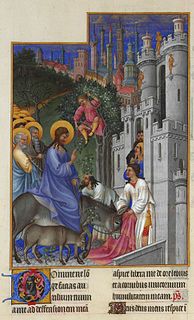
In some traditions of Christianity, Holy Week is the most sacred week in the Church year. In Eastern Rite Churches, also known as Eastern Orthodox, Holy Week occurs the week after Lazarus Saturday and starts on the evening of Palm Sunday. In the rites of the Western/Latin/Roman Church it begins with Palm Sunday and concludes on Easter Sunday. For all Christian traditions it is a moveable observance. In Eastern Rite Churches, Holy Week starts after 40 days of Lent and two transitional days, namely Saturday of Lazarus and Palm Sunday. In Western Rite Churches, Holy Week falls on the last week of Lent or Sixth Lent Week.

Pampanga, officially the Province of Pampanga is a province in the Central Luzon region of the Philippines. Lying on the northern shore of Manila Bay, Pampanga is bordered by Tarlac to the north, Nueva Ecija to the northeast, Bulacan to the east, the Manila Bay to the central-south, Bataan to the southwest and Zambales to the west. Its capital is the City of San Fernando. Angeles City is the largest LGU but while geographically within Pampanga, it is classified as a first-class, highly urbanized city and has been governed independently of the province since it received its charter in 1964.

San Pedro Cutud is a barangay in City of San Fernando, Pampanga province in the Philippines, approximately 70 kilometers north of Manila. It is known for annual re-enactments of the crucifixion of Jesus. During Holy Week each year, thousands of penitents arrive in the area to watch and take part in a pageant commemorating the passion, death and resurrection of Jesus, including the Good Friday flagellation and crucifixion rituals. A small number of participants choose to have their hands and feet temporarily nailed to makeshift crosses as a sign of faith and repentance; some undergo the ritual yearly.
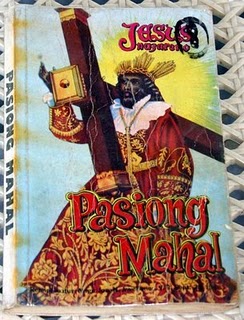
The Pasyón is a Philippine epic narrative of the life of Jesus Christ, focused on his Passion, Death, and Resurrection. In stanzas of five lines of eight syllables each, the standard elements of epic poetry are interwoven with a colourful, dramatic theme.
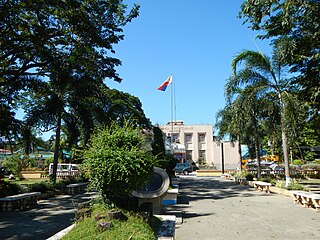
Apalit, officially the Municipality of Apalit, is a 1st class municipality in the province of Pampanga, Philippines. According to the 2015 census, it has a population of 107,965 people.
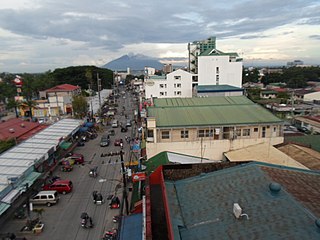
Angeles, officially the City of Angeles, is a 1st class highly urbanized city in the province of Pampanga, where it is geographically situated but remains politically independent. It is located in the region of Central Luzon, Philippines. According to the 2020 census, it has a population of 462,928 people.
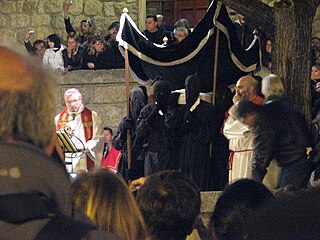
A Holy Week procession is a public ritual march of clergy and penitents which takes place during Holy Week in Christian countries, especially those with a Catholic culture. Various images of the saints, especially the Virgin Mary, and most importantly the image of the crucified Christ are carried aloft by foot as a penance; acts of mortification are carried out; traditional Christian hymns and chants are sung. In many confraternities of penitents, the faces of the members are covered by elaborate hoods, such as the capirote, as a way of hiding one's identity in order to not ostentatiously draw attention to oneself while performing penance. Crosses, and biers holding Catholic holy images surrounded with flowers and offerings of candles, are carried usually from one parish church to another led by the clergy, monastic orders, or heads of the penitential orders.
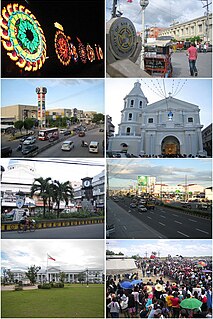
San Fernando, officially the City of San Fernando, is a 1st class component city and capital of the province of Pampanga, Philippines. According to the 2020 census, it has a population of 354,666 people.

Mexico, officially the Municipality of Mexico, is a 1st class municipality in the province of Pampanga, Philippines. According to the 2015 census, it has a population of 154,624 people. It was also formerly known as Nuevo México during the Spanish period.

The Giant Lantern Festival is an annual festival held in mid-December in the City of San Fernando in the Philippines. The festival features a competition of giant parol lanterns. Because of the popularity of the festival, the city has been nicknamed the "Christmas Capital of the Philippines".
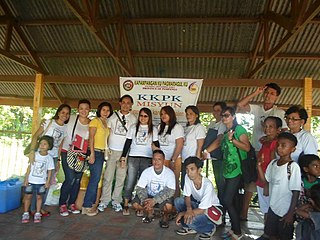
The Kapampangan people, Pampangueños or Pampangos, are the sixth largest ethnolinguistic group in the Philippines, numbering about 2,784,526 in 2010. They live mainly in the provinces of Pampanga, Bataan and Tarlac, as well as Bulacan, Nueva Ecija and Zambales.
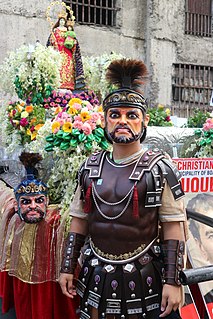
The Moriones is a lenten festival held annually on Holy Week on the island of Marinduque, Philippines. The "Moriones" are men and women in costumes and masks replicating the garb of biblical Imperial and Royal Roman soldiers as interpreted by locals. The Moriones tradition has inspired the creation of other festivals in the Philippines where cultural practices is turned into street festivals.

Lent is a religious observance in the Christian liturgical calendar that begins on Ash Wednesday and ends approximately six weeks later; depending on the Christian denomination and local custom, Lent concludes either on the evening of Maundy Thursday, or at sundown on Holy Saturday, when the Easter Vigil is celebrated. Regardless, Lenten practices are properly maintained until the evening of Holy Saturday. In Eastern Churches, whether Eastern Orthodox, Eastern Lutheran or Eastern Catholic, Lent ends at noon of Holy Saturday.
Holy Week in the Philippines is a significant religious observance for the country's Catholic majority, the Iglesia Filipina Independiente or the Philippine Independent Church and most Protestant groups. One of the few majority Christian countries in Asia, Catholics make up 80 percent of the population, and the Church is one of the country's dominant sociopolitical forces.

Ruben Enaje is a Filipino carpenter, sign painter, and former construction worker. He is noted for being crucified 33 times as of 2019.

Holy Week in Mexico is an important religious observance as well as important vacation period. It is preceded by several observances such as Lent and Carnival, as well as an observance of a day dedicated to the Virgin of the Sorrows, as well as a Mass marking the abandonment of Jesus by the disciples. Holy Week proper begins on Palm Sunday, with the palms used on this day often woven into intricate designs. In many places processions, Masses and other observances can happen all week, but are most common on , Good Friday, Holy Saturday and Easter Sunday, with just about every community marking the crucifixion of Jesus in some way on Good Friday. Holy Saturday is marked by the Burning of Judas, especially in the center and south of the country, with Easter Sunday usually marked by a Mass as well as the ringing of church bells. Mexico's Holy Week traditions are mostly based on those from Spain, brought over with the Spanish conquest of the Aztec Empire, but observances have developed variations in different parts of the country due to the evangelization process in the colonial period and indigenous influences. Several locations have notable observances related to Holy Week including Iztapalapa in Mexico City, Taxco, San Miguel de Allende and San Luis Potosí.

The Passion Play of Iztapalapa is an annual event during Holy Week in the Iztapalapa borough of Mexico City. It one of the oldest and most elaborate passion plays in Mexico as well as the best known, covered by media both in Mexico and abroad. Unlike others in Latin America, its origins are not in the colonial period but rather in a cholera epidemic in the 19th century, which gave rise to a procession to petition relief. Over time, the procession included a passion play which grew to include various scenes related to Holy Week. Today, the play includes not only hundreds of actors but also thousands of men called “Nazarenes” who carry their own crosses to follow the actor chosen to play Jesus to the site where the crucifixion is reenacted. While the event is still primarily religious, it has also become a rite of identity for Iztapalapa as well as a major tourism attraction for both the borough and the city.
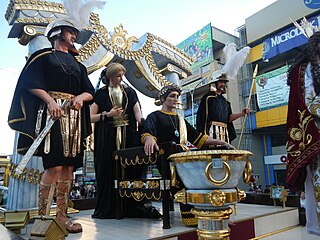
Good Friday processions in Baliuag or Holy Week procession in Baliuag, Bulacan is an event taking place in Holy Week, in a traditional Roman Catholic culture of the St. Augustine Parish Church of Baliuag.

Crucifixion in the Philippines is a devotional practice held every Good Friday, and is part of the local observance of Holy Week. Devotees or penitents called magdarame in Kapampangan are willingly crucified in imitation of Jesus Christ's suffering and death, while related practices include carrying wooden crosses, crawling on rough pavement, and self-flagellation. Penitents consider these acts to be mortification of the flesh, and undertake these to ask forgiveness for sins, to fulfil a panatà, or to express gratitude for favours granted. In the most famous case, Ruben Enaje drives four-inch nails into both hands and feet and then he is lifted on a wooden cross for around five minutes.



















